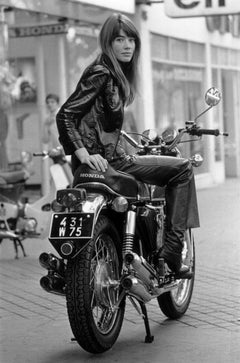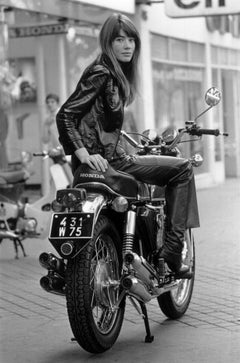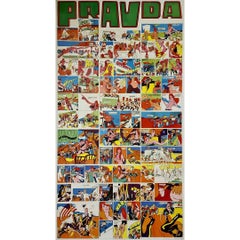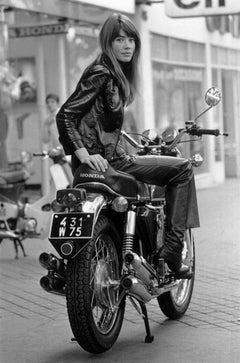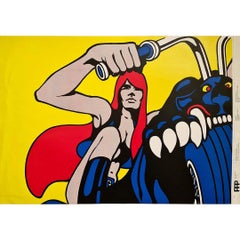Francoise Hardy
"Francoise Hardy" by Reg Lancaster
By Reg Lancaster
Located in London, GB
"Francoise Hardy" by Reg Lancaster
1969: French singer, Francoise Hardy sitting on a motorbike
Category
1960s Modern Black and White Photography
Materials
Black and White
Francoise Hardy (1969) - Silver Gelatin Fibre Print
By Reg Lancaster
Located in London, GB
Francoise Hardy (1969) - Silver Gelatin Fibre Print
(Photo by Reg Lancaster/Express/Getty Images
Category
1960s Modern Portrait Photography
Materials
Black and White, Silver Gelatin
Françoise Hardy by Jean-Marie Perier- Vintage B/w Photo - 1960s
Located in Roma, IT
Françoise Hardy by Perier is a vintage photographic print on single-coated paper.
Photograph by
Category
1960s Portrait Photography
Materials
Photographic Paper
$180 Sale Price
25% Off
H 7.09 in W 9.45 in D 0.08 in
1968 Original poster by Huy Peelaert - Pravda - Françoise Hardy - Comics
By Guy Peellaert
Located in PARIS, FR
Guy Peellaert's "Pravda with Françoise Hardy" poster, created in 1968, is a remarkable work
Category
1960s Pop Art Prints and Multiples
Materials
Linen, Lithograph, Paper
$2,164
H 48.43 in W 25.99 in
Reg Lancaster 'Francoise Hardy' Limited Edition Photographic Print, 20x30
By Reg Lancaster
Located in San Rafael, CA
1969: French singer, Francoise Hardy sitting on a motorbike. (Photo by Reg Lancaster/Express/Getty
Category
1950s Modern Black and White Photography
Materials
Photographic Paper, Silver Gelatin
Reg Lancaster 'Francoise Hardy' Limited Edition Photographic Print, 30x40
By Reg Lancaster
Located in San Rafael, CA
1969: French singer, Francoise Hardy sitting on a motorbike. (Photo by Reg Lancaster/Express/Getty
Category
1950s Modern Black and White Photography
Materials
Photographic Paper, Silver Gelatin
Reg Lancaster 'Francoise Hardy' Limited Edition Photographic Print, 20x16
By Reg Lancaster
Located in San Rafael, CA
1969: French singer, Francoise Hardy sitting on a motorbike. (Photo by Reg Lancaster/Express/Getty
Category
1950s Modern Black and White Photography
Materials
Photographic Paper, Silver Gelatin
1968 Poster by Guy Peelaert Pravda la Survireuse Françoise Hardy Pop-Art
By Guy Peellaert
Located in PARIS, FR
appropriates the angular visage and slender physique of singer Françoise Hardy, guiding his liberated heroine
Category
1960s Pop Art Prints and Multiples
Materials
Paper
$1,803
H 23.63 in W 34.26 in
Recent Sales
PURE EVIL: Jacques Dutronc's Nightmare - Françoise Hardy. Street art, Pop Art
By Pure Evil
Located in Madrid, Madrid
Jacques Dutronc's Nightmare - Françoise Hardy (Red & Black)
Date of creation: 2018
Medium: Screen
Category
2010s Pop Art Figurative Prints
Materials
Screen
PURE EVIL: Jacques Dutronc's Nightmare - Françoise Hardy. Ed. of 40. Street art
By Pure Evil
Located in Madrid, Madrid
Jacques Dutronc's Nightmare - Françoise Hardy (Endless Bummer)
Date of creation: 2018
Medium
Category
2010s Pop Art Figurative Prints
Materials
Screen
Francoise Hardy After Pure Evil lithograph numbered and signed
By Pure Evil
Located in Pasadena, CA
Original Lithograph after Pure Evil signed and numbered .costum framed .
Pure Evil is the pseudonym of Welsh graffiti artist Charles Uzzell-Edwards. His wide-ranging body of work in...
Category
Early 2000s Pop Art Portrait Prints
Materials
Lithograph
Francoise Hardy After Pure Evil lithograph numbered and signed
By Pure Evil
Located in Pasadena, CA
Original Lithograph after Pure Evil signed and numbered .costum framed .
Pure Evil is the pseudonym of Welsh graffiti artist Charles Uzzell-Edwards. His wide-ranging body of work in...
Category
Early 2000s Pop Art Portrait Prints
Materials
Lithograph
PURE EVIL: JACQUES DUTRONC'S NIGHTMARE Unique hand finished Street Pop Art
By Pure Evil
Located in Madrid, Madrid
JACQUES DUTRONC'S NIGHTMARE - FRANÇOISE HARDY: YOU COMPLETE ME
Date of creation: 2020
Medium: Hand
Category
2010s Pop Art Figurative Prints
Materials
Ink, Spray Paint, Screen, Stencil
Fluorescent Françoise - bright, vivid, contemporary, abstract, acrylic on canvas
By Fiona Ackerman
Located in Bloomfield, ON
!’
“I named it 'Fluorescent Françoise after Françoise Hardy, the 1960s French pop star whose music
Category
2010s Contemporary Paintings
Materials
Acrylic
"Francoise Hardy" by Victor Blackman
By Victor Blackman
Located in London, GB
"Francoise Hardy" by Victor Blackman
French actress Francoise Hardy at Brands Hatch to film John
Category
1960s Modern Black and White Photography
Materials
Black and White
Vintage Brigitte Bardot Vinyl Record
By Georges Delerue
Located in NEW YORK, NY
Related Categories
Jean Luc Godard. French New Wave. Jane Birkin.
Francoise Hardy. Serge Gainsbourg
Category
1960s Pop Art More Art
Materials
Offset
Get Updated with New Arrivals
Save "Francoise Hardy", and we’ll notify you when there are new listings in this category.
Francoise Hardy For Sale on 1stDibs
You are likely to find exactly the francoise hardy you’re looking for on 1stDibs, as there is a broad range for sale. You can easily find an example made in the Pop Art style, while we also have 2 Pop Art versions to choose from as well. If you’re looking for a francoise hardy from a specific time period, our collection is diverse and broad-ranging, and you’ll find at least one that dates back to the 20th Century while another version may have been produced as recently as the 21st Century. When looking for the right francoise hardy for your space, you can search on 1stDibs by color — popular works were created in bold and neutral palettes with elements of gray, beige and silver. There have been many interesting francoise hardy examples over the years, but those made by Reg Lancaster, Guy Peellaert, Fiona Ackerman and Victor Blackman are often thought to be among the most thought-provoking. Frequently made by artists working in paper, photographic paper and silver gelatin print, these artworks are unique and have attracted attention over the years. A large francoise hardy can prove too dominant for some spaces — a smaller francoise hardy, measuring 7.09 high and 9.45 wide, may better suit your needs.
How Much is a Francoise Hardy?
The average selling price for a francoise hardy we offer is $990, while they’re typically $222 on the low end and $1,993 for the highest priced.
